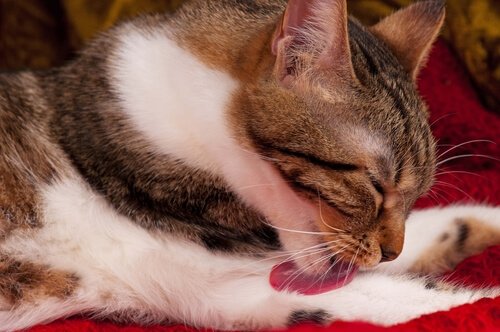Hairballs in Cats: Causes, Symptoms and Treatments

Needless to say, felines love to groom themselves and cleanse themselves … This, coupled with the rough texture of their tongues, can result in some digestive problems. Why? Well, hairballs in cats often cause the animal to vomit, feel fatigued, or get a stomachache. However, we wrote this article so you can find out how to prevent them.
How Do Hairballs in Cats Form?
If you have a cat, surely you have seen him grooming and cleaning himself on more than one occasion. This task can even take several hours… Cats won’t t stop until they’re 100% sure about being groomed. In some cases, they can even cause skin wounds due to their “scratchy” tongue (that tickle people’s skin when showing affection.)
Hairballs are very common due to this habit. In actuality, cats swallow small amounts of fur all the time, without anyone noticing it. They expel the fur by vomiting, spitting it out or eliminating it through their stools.

If cats could always expel the hairballs from their systems, they would not have any problems. However, this is not always the case. Sometimes, hairballs become “trapped” in the cat’s stomach or intestines, which causes pain, discomfort, constipation and even irritability.
If your cat has nausea, a swollen abdomen or is depressed for several days, most likely a hairball formed in his body or it has some type of digestive problem. If you notice these problems or any other behavioral changes, don’t hesitate to run a veterinarian check-up.
When to Pay Close Attention to Hairballs
You should take into consideration that a cat vomiting hairballs isn’t as normal as it seems. This is because hairballs should really not be forming in your cat’s digestive system, even if they are extremely hygienic.
When this happens, it can be a sign of something not functioning correctly in the cat’s digestive system, specifically in the intestines. When the animal doesn’t defecate properly, the hairs begin to build up along with other waste.
One of the theories to help us understand why cats are prone to the formation of those disgusting hairballs is that feline diets in this day and age are very different than their ancestors’ diets. Although cat kibble contains all the proteins a domestic cat needs, its diet should also be made up of other foods, including meat and fish.
By adding wet food to your cat’s diet, you thoroughly lubricate the animal’s digestive system and prevent what is known as “inflammatory bowel disease” or IBD. This increasingly common pathology is due to dry ingredients in regular kibble (including rice and other cereals), which explains why grain-free food is the best option for both cats and dogs.
How to Treat Hairballs in Cats
Once you and a trusted veterinarian have ruled out any severe health problems by running medical testing, the best option is to prevent hairballs from forming. You can do so by following the three tips below:
1. Feed Your Cat a Healthy Diet
Your veterinarian will probably tell you what kind of food and the amounts your cat should eat. Balance out the hopefully dry, grain-free kibble with wet foods such as cooked chicken, beef and fish, since these are healthier options than canned food. There are thousands of homemade cat recipes you can prepare.

2. Brush Your Cat On A Regular Basis
If you have a long-haired cat, such as a Persian cat, an Angora, or a Maine Coons, you should brush its coat at least once a week. Start this habit when your cat is young so he’ll consider it as a game or a positive activity, rather than something bad and annoying. Therefore, your cat will have less loose hair to swallow when he grooms himself.
3. Help Your Cat Eliminate Hairballs
There are certain herbs and plants with laxative properties your cat can eat to aid expelling fur trapped in its digestive system, such as wheat, barley and catnip. However, be sure to seek advice from a trusted veterinarian before you start planting them all over your home.